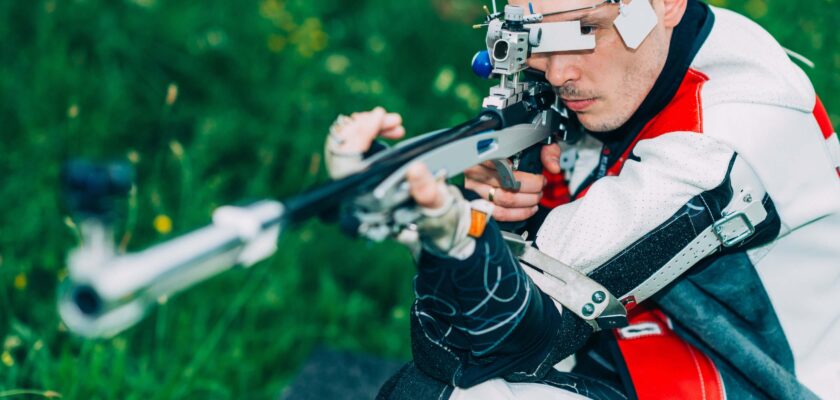Paralympic shooting is a sport developed for athletes with different types of physical disabilities. As in conventional shooting, competitors use rifles and pistols to hit targets at different distances. Find out all about paralympic shooting in our complete guide!
The rules and adaptations in Paralympic shooting allow athletes with reduced mobility or other disabilities to take part in the competition. There are different categories according to the type and degree of disability of the competitors, ensuring that everyone has a level playing field.
Paralympic shooters compete in various disciplines, in international and national competitions.
Open your Betano account and get up to 1,000 reais in bonuses.
PIX payments, live games and super odds!
Click here to open your account!
All about paralympic shooting: what it is
So first of all, it’s worth understanding what paralympic shooting is: the sport requires concentration, technique and practice. Carbines and air pistols are used in the 10-meter events. In the 25-meter event, a bore gun is used. There are also 50-meter competitions, with the use of armor-piercing rifles and pistols.
There are some significant differences between paralympic shooting and traditional shooting, mainly related to the adaptations made to allow disabled athletes to take part in the sport.
Depending on the case, athletes can use gun rests and other devices that allow for better control and stability during shooting. The rules allow equipment to be adjusted according to athletes’ individual needs, ensuring that everyone has a fair chance to compete.
How paralympic shooting works
Paralympic shooting scores are determined by how close the shots are to the center of the target. The center (the “10”) is the maximum score, with points decreasing as they move away from the center.
An athlete’s total score is calculated by adding up the points from all the valid shots taken during the competition. In addition, athletes compete in several rounds and elimination phases, depending on the format of the competition.
In short, the athlete with the highest total score at the end of the competition or elimination phase is declared the winner of that event. In larger competitions, such as the Paralympic Games, several rounds and elimination phases are held to determine the finalists and, eventually, the medalists.
All about Paralympic shooting: history
The history of Paralympic shooting officially began at the Paralympic Games in 1976, during the Paralympic Games in Toronto, Canada. Since then, it has been one of the regular disciplines.
Over the years, the rules and categories of paralympic shooting have been refined to better meet the needs of athletes with different types of disabilities.
Advances in technology and equipment manufacturing techniques have also influenced paralympic shooting. Adapted equipment, such as gun rests and motion control devices, have been developed to help athletes compete on a level playing field.
Paralympic shooting has become increasingly recognized globally as a high-level competitive sport. Athletes from various countries regularly compete in international events and at the Paralympic Games, contributing to the growth and visibility of the sport.
Paralympic shooting in Brazil
Our guide to all things Paralympic shooting continues with the history of the sport in Brazil. According to the Brazilian Paralympic Committee, the sport made its debut in the country in 1976, but the second appearance by Brazilians came only in Beijing 2008, after 32 years out of the event, with Carlos Garletti, who also competed in the London 2012 and Rio 2016 Paralympic Games.
At the Rio 2016 Games, Brazil was represented by three more athletes (Alexandre Galgani, Débora Campos and Geraldo Rosenthal), but none of them reached the podium.
Paralympic shooting at the Parapan American Games
Lima 2019, in Peru, was the first time the sport was part of the Parapan American Games program, when Alexandre Galgani, from São Paulo, won the silver medal in the standing 10m mixed air rifle. The same athlete was the country’s sole representative in the sport at the Tokyo 2020 Games.
Paralympic shooting categories
The guide to all things paralympic shooting continues with the categories: athletes compete in different shooting positions – standing, lying down and kneeling. Each position requires specific techniques to maximize precision and control during the competition.
Standing paralympic shooting
In the standing position, the athlete stands and fires the gun towards the target. The position requires good balance and body stability, as any unwanted movement can affect the accuracy of the shot.
Athletes often use armrests or other devices to help with the stability of the weapon. The position is commonly used in air pistol competitions and can vary in distance and number of shots per round, depending on the specific competition.
Paralympic shooting lying down
In the lying position, the athlete lies on the ground or on a suitable surface and shoots. The position offers greater natural stability, as the body is fully supported.
Athletes use gun rests and other devices to ensure a comfortable and stable position. The position is common in recumbent rifle competitions, where athletes compete over longer distances and can fire more shots per round.
Kneeling Paralympic shooting
In the kneeling position, the athlete kneels on the ground or on a suitable surface and shoots. The position offers a good combination of stability and flexibility of movement.
The kneeling position is less common, but can be used in rifle or pistol competitions, depending on the specifications of the event.
Paralympic shooting classes
Athletes are classified according to their balance, limb mobility, muscle strength and degree of trunk functionality. Athletes are divided into two classes: SH1 and SH2.
- SH1 Pistol and carbine shooters who do not require support for the weapon.
- SH2 Carbine shooters who do not have the ability to support the weight of the weapon with their arms and need support for the weapon.
Now that you know all about paralympic shooting – a sport that offers a valuable opportunity for athletes with disabilities to demonstrate their skills of precision, concentration and control – stay tuned to our website for similar content:



